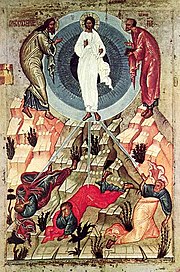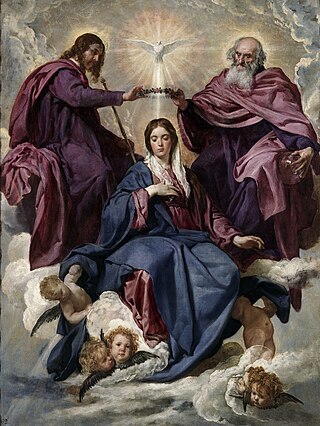
Queen of Heaven is a title given to the Virgin Mary, by Christians mainly of the Catholic Church and, to a lesser extent, in Anglicanism, Lutheranism, and Eastern Orthodoxy. The title has long been a tradition, included in prayers and devotional literature and seen in Western art in the subject of the Coronation of the Virgin from the High Middle Ages, long before it was given a formal definition status by the Church.
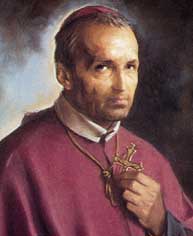
Alphonsus Liguori, CSsR, sometimes called Alphonsus Maria de Liguori or Saint Alphonsus Liguori, was an Italian Catholic bishop, spiritual writer, composer, musician, artist, poet, lawyer, scholastic philosopher, and theologian. He founded the Congregation of the Most Holy Redeemer, known as the Redemptorists, in November 1732.

The "Salve Regina", also known as the "Hail Holy Queen", is a Marian hymn and one of four Marian antiphons sung at different seasons within the Christian liturgical calendar of the Catholic Church. The Salve Regina is traditionally sung at Compline in the time from the Saturday before Trinity Sunday until the Friday before the first Sunday of Advent. The Hail Holy Queen is also the final prayer of the Rosary.

Catholic Mariology is Mariology in Catholic theology. According to the Immaculate Conception taught by the Catholic Church, she was conceived and born without sin, hence Mary is seen as having a singular dignity above the saints, receiving a higher level of veneration than all angelic spirits and blessed souls in heaven. Catholic Mariology thus studies not only her life but also the veneration of her in daily life, prayer, hymns, art, music, and architecture in modern and ancient Christianity throughout the ages.

Marian devotions are external pious practices directed to the person of Mary, mother of God, by members of certain Christian traditions. They are performed in Catholicism, High Church Lutheranism, Anglo-Catholicism, Eastern Orthodoxy and Oriental Orthodoxy, but generally rejected in other Christian denominations.

Our Lady of Good Counsel is a title given to the Blessed Virgin Mary, after a painting said to be miraculous, now found in the thirteenth century Augustinian church at Genazzano, near Rome, Italy. Measuring 40 to 45 centimetres the image is a fresco executed on a thin layer of plaster no thicker than an egg shell. Over the centuries, devotions to Our Lady of the Good Counsel grew among saints and Popes, to the extent that a reference to it was added to the Litany of Loreto and the devotion spread throughout the world. Her feast day is 26 April.
Anglican Marian theology is the summation of the doctrines and beliefs of Anglicanism concerning Mary, mother of Jesus. As Anglicans believe that Jesus was both human and God the Son, the second Person of the Trinity, within the Anglican Communion and Continuing Anglican movement, Mary is accorded honour as the theotokos, a Koiné Greek term that means "God-bearer" or "one who gives birth to God".

Three Hail Marys are a traditional Roman Catholic devotional practice of reciting Hail Marys as a petition for purity and other virtues. Believers recommend that it be prayed after waking in the morning, and before going to bed. This devotion has been recommended by SS. Anthony of Padua, Alphonsus Liguori, John Bosco and Leonard of Port Maurice. Two saints, Mechtilde and Gertrude the Great, are said to have received revelations from the Blessed Virgin Mary regarding this practice.

Mary, the mother of Jesus in Christianity, is known by many different titles, epithets, invocations, and several names associated with places.

Mediatrix is a title given to Mary, mother of Jesus in Christianity. It refers to the intercessory role of the Blessed Virgin Mary as a mediator in the salvific redemption by her son Jesus Christ and that he bestows graces through her. Mediatrix is an ancient title that has been used by many saints since at least the 5th century. Its use grew during the Middle Ages and reached its height in the writings of saints Louis de Montfort and Alphonsus Liguori in the 18th century.

Rosary-based prayers are Christian prayers said on a set of rosary beads, among other cords. These prayers recite specific word sequences on different parts of the rosary beads. They may be directed to Jesus Christ, the Virgin Mary or God the Father.

Throughout history, Catholic Mariology has been influenced by a number of saints who have attested to the central role of Mary in God's plan of salvation. The analysis of Early Church Fathers continues to be reflected in modern encyclicals. Irenaeus vigorously defended the title of "Theotokos" or Mother of God. The views of Anthony of Padua, Robert Bellarmine and others supported the doctrine of the Immaculate Conception of the Virgin Mary, which was declared a dogma in 1850.

The veneration of Mary in the Catholic Church encompasses various devotions which include prayer, pious acts, visual arts, poetry, and music devoted to her. Popes have encouraged it, while also taking steps to reform some manifestations of it. The Holy See has insisted on the importance of distinguishing "true from false devotion, and authentic doctrine from its deformations by excess or defect". There are significantly more titles, feasts, and venerative Marian practices among Roman Catholics than in other Western Christian traditions. The term hyperdulia indicates the special veneration due to Mary, greater than the ordinary dulia for other saints, but utterly unlike the latria due only to God.

In Christian worship, Marian litany is a form of prayer to the Blessed Virgin Mary used in church services and processions, and consisting of a number of petitions.
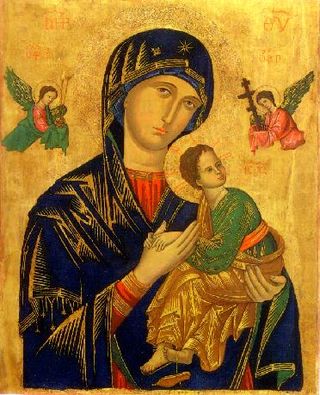
Mary has been one of the major subjects of Western Art for centuries. There is an enormous quantity of Marian art in the Catholic Church, covering both devotional subjects such as the Virgin and Child and a range of narrative subjects from the Life of the Virgin, often arranged in cycles. Most medieval painters, and from the Reformation to about 1800 most from Catholic countries, have produced works, including old masters such as Michelangelo and Botticelli.

Refugium Peccatorum meaning Refuge of Sinners is a Catholic title for the Blessed Virgin Mary. Its use goes back to Saint Germanus of Constantinople in the 8th century.

The Feast of the Most Holy Name of the Blessed Virgin Mary is an optional memorial celebrated in the liturgical calendar of the Catholic Church on 12 September. It has been a universal Roman Rite feast since 1684, when Pope Innocent XI included it in the General Roman Calendar to commemorate the victory at the Battle of Vienna in 1683. It was removed from the Church calendar in the liturgical reform following Vatican II but restored by Pope John Paul II in 2002, along with the Feast of the Holy Name of Jesus.
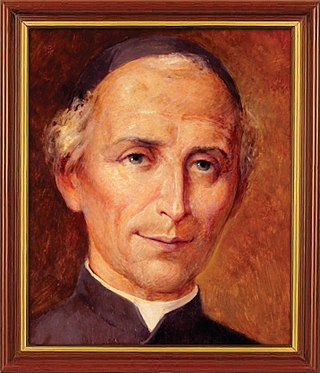
Pio Bruno Pancrazio Lanteri, or simply Bruno Lanteri, was a Catholic priest and founder of the religious congregation of the Oblates of the Virgin Mary in the Kingdom of Piedmont-Sardinia in northwestern Italy in the early 19th century. His spiritual life and work centered on the Spiritual Exercises of St. Ignatius of Loyola. He was also renowned for challenging Jansenism by distributing books and other publications that promoted the moral theology of St. Alphonsus Liguori, as well as establishing societies to continue this work.
The rosary is one of the most notable features of popular Catholic spirituality. According to Pope John Paul II, rosary devotions are "among the finest and most praiseworthy traditions of Christian contemplation." From its origins in the twelfth century the rosary has been seen as a meditation on the life of Christ, and it is as such that many popes have approved of and encouraged its recitation.

Evviva Maria is a usual thanksgiving cry used by Roman Catholics as an expression of popular devotion in honor of the Blessed Virgin Mary. It is a devotion promoted by a hymn composed by Capuchin friar Leonard of Port-Maurice at the beginning of the 18th century and associated with the devotion the Holy Name of Jesus and the Holy Name of Mary encouraged by various Popes since the time of Pius VI.

